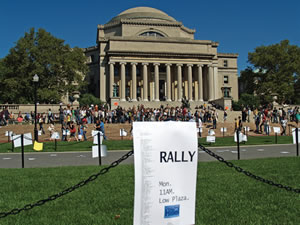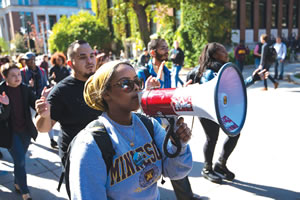Managing Campus Visitors
- By Michael Fickes
- 04/01/17

PHOTO COURTESY OF DAVID SHANKBONE
Violent events in American society have led college and university security directors to
change the way they manage campus visitors.
Time was, open campuses offered a warm welcome to visitors —
townspeople and others — who were not part of the campus community.
Of course, campuses employed security forces. “In the
past, security officers had certain posts, perhaps at each entrance
to the campus,” says Paul Timm, president of RETA Security, Inc.
in Lemont, IL. “Others had fixed patrol routes.”
Under this system, members of the community as well as visitors
pretty much came and went as they pleased. Security reacted
when something needing a response happened.
Occasionally, a protest or a pep rally broke out and security would
watch a little closer. Their presence often deterred trouble. If it didn’t
and trouble erupted, they would step in quickly to handle the problem.
It’s Different Today
These days, college and university security people have decided
that such an approach is too open. Security officers aim to be
proactive, spot developing problems — caused by individuals or groups — and cut the problems off before
an incident occurs. It doesn’t always work,
but that’s the goal.
To facilitate that goal, college and
university security professionals have
moved beyond the fixed security station
and predictable patrol routes of yesterday.
“Today, security officers on patrol will stop
to engage visitors,” says Timm. “We’ll approach
visitors and speak to them: ‘Hello,
welcome to our campus. May I help you
find your destination?’
“When engaging visitors, security officers
actively look for potential risks. We
count on people to intervene, discourage
and stop unwanted activity.”
Today, these and other visitor management
procedures are followed by campus
security as well as law enforcement officers
assigned to a campus. Police officers, of
course, undergo training that enables them
to intervene and tamp down emotions
when necessary.
Security officers can be trained in the
same techniques. In fact, some security
directors put their officers through formal
police training programs to give them the
skills they need to manage trouble.
Who’s Coming to Visit?
A key visitor management issue involves
identifying visitors. “This is a difficult
issue,” says Kevin Davis, J.D., CPP, 1st vice
chair with the ASIS International School
Safety and Security Council. “Most campuses
want to maintain an open and inviting atmosphere.
Yet many campuses cover many
acres and consist of many buildings and
outdoor areas, making it difficult to identify
visitors and control access to campus.
“Some campuses are gated or located
in a low number of buildings, making it
relatively easy to control access. Security
on these campuses can require visitors to
wear distinctive visitor ID badges when
entering the campus.”
Davis also notes the difficulties any
school will have controlling access when
hosting outside activities and rallies on
campus.
Large and Small Schools
“There are different strategies for managing
people on campus in small and large
schools,” says Rick Thompson, a former
campus security consultant with RETA
Security. RETA recently merged with Facility
Engineering Associates (FEA), a Washington,
DC-based engineering consulting firm with
offices around the country.
Smaller schools, continues Thompson,
can manage access with little more than a
fence and a gate with a guard.
“We’ve found that the best way to
control access in larger schools with many
buildings is to focus on each individual
building,” he says. “You can use photo ID
badges and a single access point in each
building. Everyone goes past a security
desk at the entrance staffed by a security
person — or someone that works in the
building. Everyone coming in displays a
badge. Visitors that don’t have badges must
check in at the desk and show an ID.”
It’s best to have a system that enables
you to make a photo ID for visitors. There
are two reasons for this. First, in today’s
world, it is simply too risky to allow potential
bad actors into your buildings. Second,
if there is an emergency — a fire or an
earthquake, for instance — security must
make sure that everyone gets out of the
building safely. To do that, officers must
rely on employee and visitor records that
report the total number of people in the
building and their names.
Why not just count people going into
the building? Certainly that is a faster,
easier method. Then again, a more formal
system that issues photo ID badges will
provide more accurate information in the
event of an emergency.
Thompson relates the example of a college
in a Midwestern city — he didn’t want
to name the school — that has set up a
comprehensive visitor management system
based on photo ID badges.
“The IDs are good for one day, and they
are programmed to control access,” he says.
“Inside campus buildings, certain areas have
different access control priorities. There are
data centers, rare book rooms in the library,
chemistry labs, artists’ studios, executive
floors and so on. At this school, security can
program key fobs and cards to provide access
to each of the areas individual students and
faculty members need to visit.
“As a result, everyone can move freely
around campus going where their fobs and
cards will let them go.”

PHOTO COURTESY OF FIBONACCI BLUE
Managing Group Gatherings
and Protests
Managing students, faculty and community
visitors has a routine to it that
works well when applied consistently.
But what about group gatherings and
protests, which need large open spaces —
like those available on college and university
campuses. Colleges and universities
have always been focal points to express
political and social views, observes Davis
from ASIS. The prevalence of protests
appears to be cyclical, driven by the social
make-up of each generation — protests
were commonplace during the Vietnam
era, but virtually unheard of during the
’80s and early ’90s.
“Today’s millennials are a very connected
generation, with social media and
the Internet providing a quick medium to
find like-minded individuals,” Davis says.
“As a result, the trend of social rallies and
protests has strengthened in recent years.
Media coverage has also helped to propel
rallies and protests to the forefront.”
How do you manage events such as
these, where violence might lurk as close as
an outbreak of ill temper? “Most colleges
and universities have plans to manage
large crowds, especially potentially unruly
crowds,” Davis says. “For instance, when
events are pre-planned, extra officers,
and in some cases, local law enforcement
agencies are called in to help manage the
crowd. The goal is to keep the rally as non-confrontational
as possible.”
Many schools designate certain areas
for rallies and demonstrations, continues
Davis. “This affords each group the
right to peaceably assemble while helping
police and security manage the crowd,”
he says.
Today, campus visitors come as
individuals, groups and crowds, all of
whom present management challenges.
The key to effective management seems
to be planning for various types of groups
that may appear, either spontaneously or
by way of a plan. Ask the police for help in
setting up plans.
How many security and police officers
will it take to manage 50 people? One
hundred people? Five hundred people?
Is it a pep rally for a football game or
an angry protest against a controversial
speaker? How soon can the police arrive
with enough officers to provide effective
management?
Considering this, all schools need a basic
plan as well as modifications that reflect
variations in the goals of different groups.
Campus officials must plan to manage
individual visitors and small groups as well
as pep rallies and, perhaps, large protest
movements. And they must create responses
ahead of time — because there will be
no time to figure things out from scratch
once a group begins to form. At that point,
it’s time to spring into action.
This article originally appeared in the issue of .